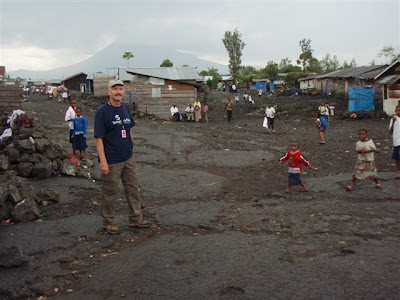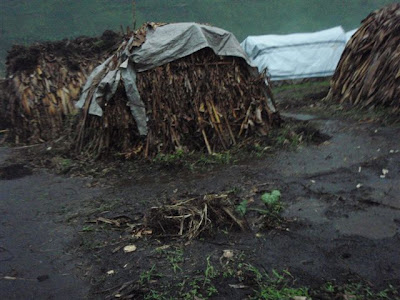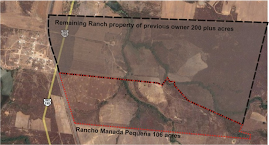 This is a photo of a street; well actually a whole portion of the city of Goma, that was totally covered with lava in the 2000 eruption of the volcano just visible behind me in the background. We were in this neighbourhood delivering left over dry food from one of the distributions to an orphanage. As we got out of the vehicle, the children greeted us in song and lively clapping and dance. These children were orphaned as a result of the war here.
This is a photo of a street; well actually a whole portion of the city of Goma, that was totally covered with lava in the 2000 eruption of the volcano just visible behind me in the background. We were in this neighbourhood delivering left over dry food from one of the distributions to an orphanage. As we got out of the vehicle, the children greeted us in song and lively clapping and dance. These children were orphaned as a result of the war here.The volcano in the background generates its own cloud of steam that pretty much constantly covers the top. I’m estimating it’s 25 km away, and it is 10,500 ft. Some of the evenings, we can look up at it and there is an amazing red glow in the sky. It erupted last in 2000. Most of Goma and the surrounding 100kms were covered by lava by varying amounts from this or other eruptions. Everywhere you go around here there is lava rock. It has got to be hard on those with bare feet.
 This is our Goma warehouse, where local staff are preparing personal hygiene kits containing tooth paste and brushes, diaper material, string, soap, towels, and many more non food items. These will be distributed by Care to IDP”s most in need.
This is our Goma warehouse, where local staff are preparing personal hygiene kits containing tooth paste and brushes, diaper material, string, soap, towels, and many more non food items. These will be distributed by Care to IDP”s most in need. This is the line up waiting for the food distribution today outside the Baptist Church. It is a very organized process thanks to the leadership provided to the local church through SP staff.
This is the line up waiting for the food distribution today outside the Baptist Church. It is a very organized process thanks to the leadership provided to the local church through SP staff. This is one of about 11,000 people benefiting from Samaritan’s Purse food distribution today through the local Baptist Church. She is carrying a sack of flour which she will have to divide among a group of people grouped together to make the distribution process more expedient.
This is one of about 11,000 people benefiting from Samaritan’s Purse food distribution today through the local Baptist Church. She is carrying a sack of flour which she will have to divide among a group of people grouped together to make the distribution process more expedient. This was one of the hand wash stations we had provided for the latrines in Buganga IDP Camp. We also provided cleaning tools for these latrines which were turned over to family groupings who will keep them cleaned. We have also acquired soap for everyone at the camp through UNICEF/Hope In Action which should be distributed Monday.
This was one of the hand wash stations we had provided for the latrines in Buganga IDP Camp. We also provided cleaning tools for these latrines which were turned over to family groupings who will keep them cleaned. We have also acquired soap for everyone at the camp through UNICEF/Hope In Action which should be distributed Monday. Patmos IDP Camp. We were at the Patmos Baptist Church IDP camp today where there has been a suspected large number of cholera cases. We’re building 26 latrines, and working on a water supply to offer relief from hauling water from lake 1km away and 42 meter vertical climb back to camp. We told the folks there that we are hoping to bring plastic covering for their huts, and they started applauding...they are so grateful for what we are doing for them.
Patmos IDP Camp. We were at the Patmos Baptist Church IDP camp today where there has been a suspected large number of cholera cases. We’re building 26 latrines, and working on a water supply to offer relief from hauling water from lake 1km away and 42 meter vertical climb back to camp. We told the folks there that we are hoping to bring plastic covering for their huts, and they started applauding...they are so grateful for what we are doing for them. These are the guys that are hand excavating...or should I say human powered rock drills...for the latrines at Patmos IDP Camp. Lava is prevalent everywhere in and about Goma, as the last eruption of the steaming night glowing volcano was in 2000. These guys weren’t even using the shovel to take the broken rock and soil out of the excavation; they were using their bare hands, as the shovel doesn’t fit into the irregularities created in broken lava. There were ladies and children from the camp picking through the rubble they excavate out of the hole and sifting through to gather the stone and some of the sand that will be used for the concrete foundation for the latrine. We asked the local contractor to use labour from the camp.
These are the guys that are hand excavating...or should I say human powered rock drills...for the latrines at Patmos IDP Camp. Lava is prevalent everywhere in and about Goma, as the last eruption of the steaming night glowing volcano was in 2000. These guys weren’t even using the shovel to take the broken rock and soil out of the excavation; they were using their bare hands, as the shovel doesn’t fit into the irregularities created in broken lava. There were ladies and children from the camp picking through the rubble they excavate out of the hole and sifting through to gather the stone and some of the sand that will be used for the concrete foundation for the latrine. We asked the local contractor to use labour from the camp.This was a photo during a significant rainstorm at Buganga IDP Camp. To add insult to injury for the inhabitants here, I saw one of the ladies bailing out her hut, as the makeshift berm she had built around her hut had not sufficed.














































